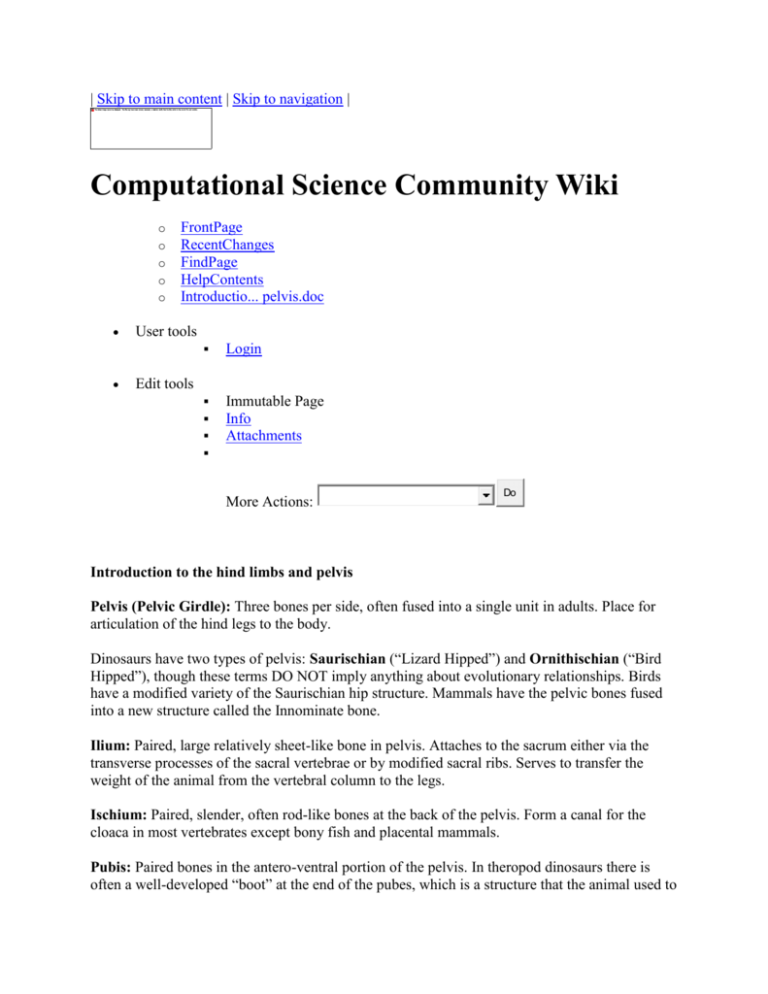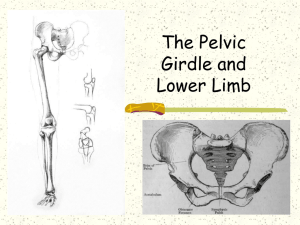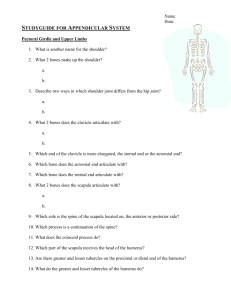Introduction to the hind limbs and pelvis
advertisement

| Skip to main content | Skip to navigation | Computational Science Community Wiki o o o o o FrontPage RecentChanges FindPage HelpContents Introductio... pelvis.doc User tools Login Immutable Page Info Attachments Edit tools More Actions: Do Introduction to the hind limbs and pelvis Pelvis (Pelvic Girdle): Three bones per side, often fused into a single unit in adults. Place for articulation of the hind legs to the body. Dinosaurs have two types of pelvis: Saurischian (“Lizard Hipped”) and Ornithischian (“Bird Hipped”), though these terms DO NOT imply anything about evolutionary relationships. Birds have a modified variety of the Saurischian hip structure. Mammals have the pelvic bones fused into a new structure called the Innominate bone. Ilium: Paired, large relatively sheet-like bone in pelvis. Attaches to the sacrum either via the transverse processes of the sacral vertebrae or by modified sacral ribs. Serves to transfer the weight of the animal from the vertebral column to the legs. Ischium: Paired, slender, often rod-like bones at the back of the pelvis. Form a canal for the cloaca in most vertebrates except bony fish and placental mammals. Pubis: Paired bones in the antero-ventral portion of the pelvis. In theropod dinosaurs there is often a well-developed “boot” at the end of the pubes, which is a structure that the animal used to rest upon when sitting. In birds, which are modified theropod dinosaurs, the pubis is turned backward, or retroverted. Acetabulum: The hip socket. This is the articular surface for the head of the femur. In dinosaurs, the acetabulum is an open hole, while in mammals and most other vertebrates, the acetabulum is closed, making a cup-shaped socket of bone. This probably resulted in different style of locomotion in dinosaurs. Femur: The thigh bone. This is the largest bone in the human body, and is often the largest bone in a vertebrate. However, in many fast-running animals, the tibia is longer than the femur. The femur has several structures that are important. They are: o Head: The ball for articulation into the pelvis Distal Condyles: The roller surface for articulation with the Tibia Greater Trochanter: Large proximo-lateral muscle attachment area Fourth Trochanter: Large muscle attachment mid-way down shaft Shaft: Also called Diaphysis Tibia: The larger of the two lower leg bones. The tibia sometimes fuses with the Astragulus and Calcaneum to form a Tibiotarsus in theropod dinosaurs and birds. The Cnemial Crest is a muscle attachment on the proximal end of the Tibia for insertion of the gastrocnemius muscle, which are the calf muscles. Fibula: The smaller of the two lower leg bones. In birds, the fibula is often reduced to being a splint of bone along the proximal shaft of the tibia. Astragalus: Large ankle bone, that articulates with the distal end of the Tibia, and the Calcaneum. The ascending process of the astragalus is often used to determine identity in theropod dinosaurs. Calcaneum: Small ankle bone that articulates with the Astragalus and the distal end of the Fibula. Tarsals: Bones that make up the ankle. The Astragalus and Calcaneum are tarsals, though there are usually at least two more aside from them. Metatarsals: Bones that extend from the ankle to the base of the toes. In birds, these fuse, along with one or two tarsals (not the Astragalus or Calcaneum) into the Tarsometatarsus. Derived theropod dinosaurs have what is called an Arctometatarsalian Pes, which is defined as having the third (middle) metatarsal pinched and reduced between the second (inner) and fourth (outer) metatarsals. It appears from the front that the third metatarsal pinches out before it reaches the ankle, but the third metatarsal is present behind the other two. In further derived forms, such as birds, the arctometatarsalian condition is advanced to the point of the proximal portion of the third metatarsal is pinched out completely, or the metatarsals fuse into the Tarsometatarsus. Tarsometatarsus: Fused metatarsals in bird feet. Pes Digits: Again, labelled from inside to outside. Labelled using Roman Numerals. Dinosaurs have three-toed feet, with Digit I being reduced to a small claw on the back of the foot (Hallux), and Digits II, III, and IV contacting the ground. Digit V is reduced to only a splint-like Metatarsal, which probably not visible in life. Pes Phalanges: Toe bones Terminal Ungual Phalanges: Claws on tips of toes Pes: Scientific word for Foot. Patella: Knee Cap. Only found in mammals. Bookmark with: Delicious Digg reddit Facebook StumbleUpon | Disclaimer | Privacy | Copyright notice | Accessibility | Freedom of information | IT Services, The University of Manchester, Manchester, UK, M13 9PL | Community Wiki Royal Charter Number: RC000797








